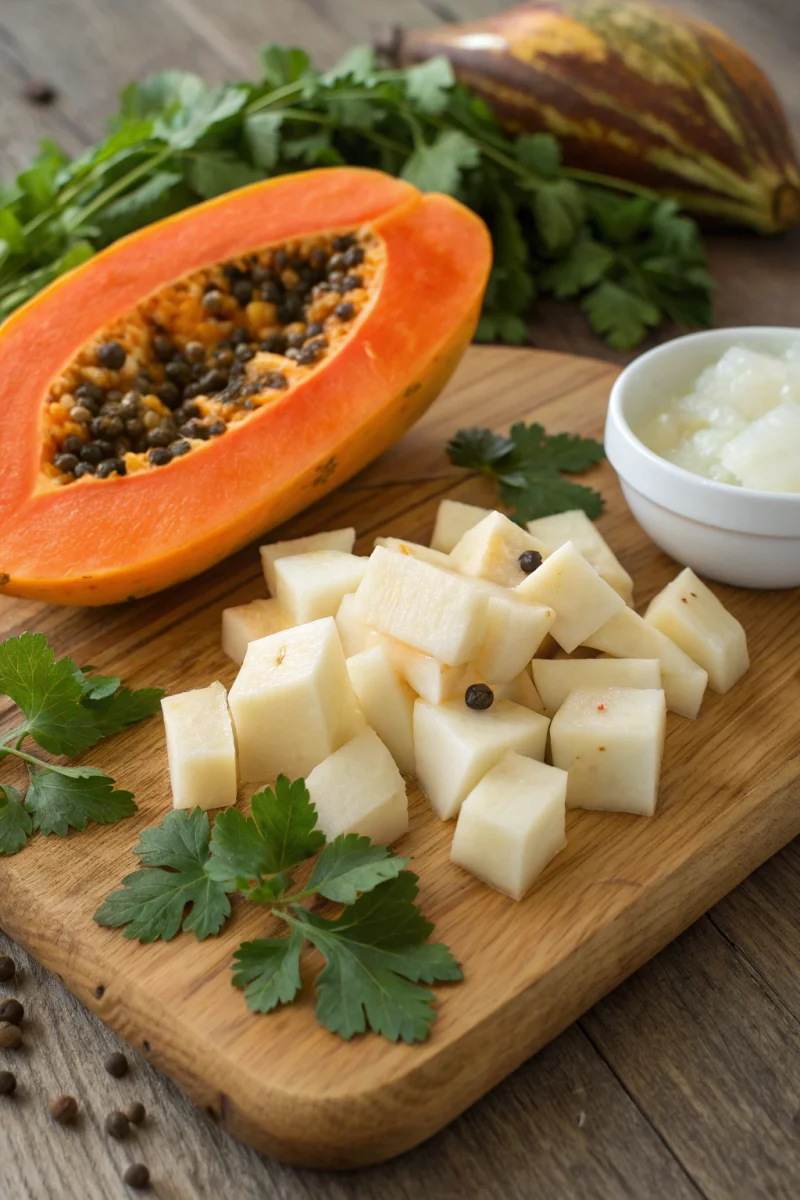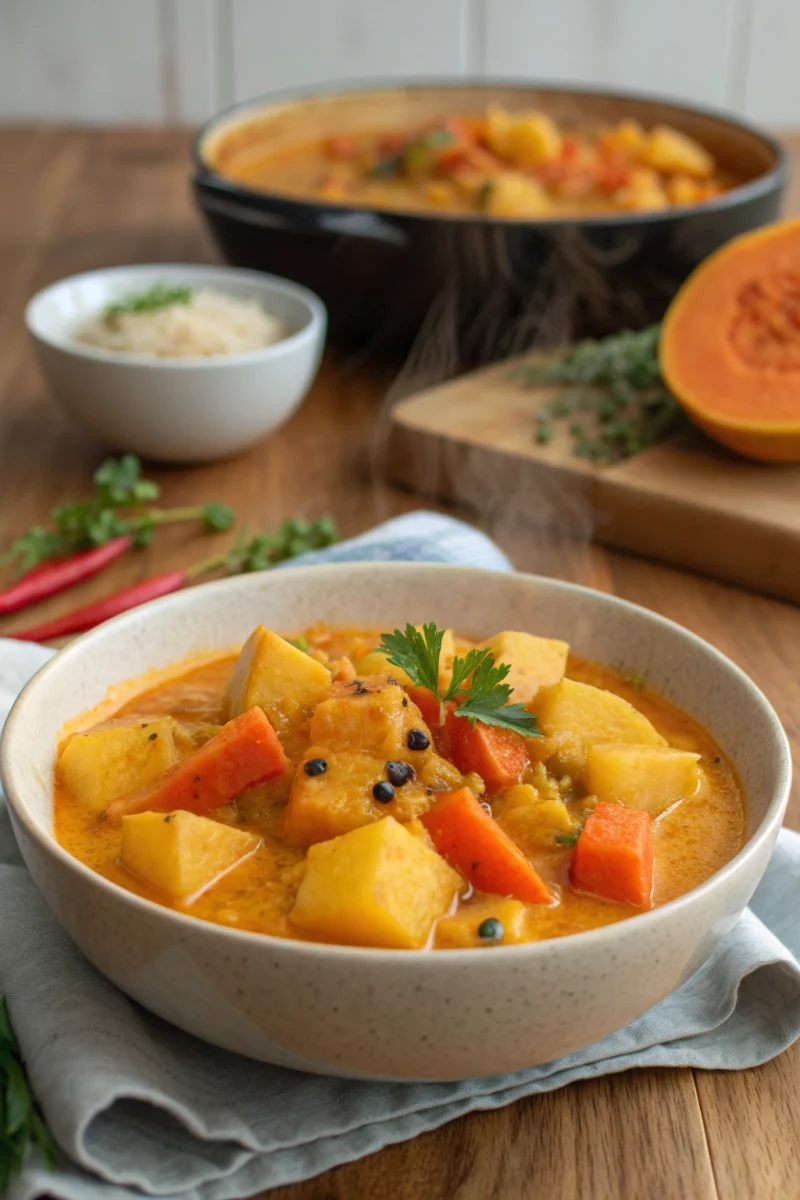Papaya Potato Curry (Creamy, Cozy & Healthy)
Papaya Potato Curry brings green papaya and tender potatoes together in a creamy coconut gravy scented with turmeric, cumin, and coriander—comforting enough for fall, light enough for everyday.

🍴 Click here if you’re still hungry
Introduction
Ever wonder if a dish can be both incredibly flavorful and surprisingly healthy? This papaya potato curry busts that myth wide open! With its vibrant colors and aromatic spices, this recipe proves that rich taste doesn’t have to come at the expense of well-being. Get ready to discover a delightful papaya potato curry that tantalizes your taste buds and nourishes your body.
Green (unripe) papaya has long been a quiet hero in South and Southeast Asian kitchens. Its firm texture stands up to simmering, its mild flavor welcomes spices, and the natural enzymes in papaya lend a gentle tenderness to stews. Pairing papaya with potatoes creates a satisfying contrast—papaya holds a pleasant bite while potato brings familiar comfort and creaminess. Swaddled in coconut milk and layered with turmeric, cumin, and coriander, the finished curry is soothing, fragrant, and wonderfully autumn-friendly.
This guide goes well beyond a basic recipe. You’ll learn how to choose the right papaya, how to cube potatoes so they cook evenly, how to build a spice base that’s aromatic but not harsh, and how to control heat and simmering so your sauce turns silky without splitting. You’ll also find smart substitutions, nutrition notes, storage advice, serving ideas, and a troubleshooting section to fix common issues like watery sauce or mushy vegetables. By the end, you’ll have a reliable blueprint you can adapt to your pantry and preferences.
Ingredients List

- 2 tablespoons coconut oil (for a rich, tropical base)
- 1 large onion, finely chopped
- 3 cloves garlic, minced
- 1-inch piece ginger, grated
- 1 teaspoon turmeric powder
- 1 teaspoon ground cumin
- 1 teaspoon ground coriander
- 1/2 teaspoon cayenne pepper (to taste)
- 1 large green papaya, peeled, seeded, diced into 1-inch cubes
- 2 medium potatoes, peeled, diced into 1-inch cubes
- 1 (13.5 oz) can full-fat coconut milk
- 1 cup vegetable broth (low sodium)
- Salt to taste
- Fresh cilantro, chopped (garnish)
Alternatives:
- Potatoes: Sweet potatoes or butternut squash for a slightly sweeter profile.
- Green Papaya: Unripe mango offers similar firmness and tang (timings vary slightly).
- Heat: Swap cayenne for paprika; add a green chili for extra kick.
Prep Time
- Prep: 20 minutes
- Cook: 30 minutes
- Total: 50 minutes (~15% faster than slow-cooked curries)
Ingredient Notes & Buying Guide
Green Papaya: Heavy for its size with firm, green-to-light-green skin. Avoid fully ripe orange flesh for this recipe. Remove white seeds and pith; dice evenly to match potato cook time.
Potatoes: Waxy/all-purpose types (Yukon Gold, Charlotte) hold shape better; very starchy potatoes can thicken the sauce—watch doneness.
Aromatics: Finely diced onion softens faster; grated ginger releases juices; minced garlic disperses evenly for consistent flavor.
Spices: Turmeric for earth + color; cumin for warmth; coriander for citrusy lift; cayenne is your adjustable heat dial. Optional: bloom 1/2 tsp mustard seeds and 8–10 curry leaves before sautéing onion.
Coconut milk: Full-fat gives body and a satin finish. Light coconut milk works—simmer gentler/longer.
Broth: Low-sodium keeps salt in check. Water also works if you build flavor with aromatics and spices.
Preparation Steps
Step 1: Sauté Aromatics
Heat the coconut oil in a large pot or Dutch oven over medium heat. Add onion; sauté 5–7 minutes until translucent and lightly golden. Tip: Properly softened onions add sweetness and depth.
Step 2: Build the Spice Base
Stir in garlic and ginger for 1 minute until fragrant. Add turmeric, cumin, coriander, and cayenne; toast 30 seconds, stirring constantly. If spices catch, splash a spoon of water.
Step 3: Add Papaya and Potatoes
Add diced papaya and potatoes; toss to coat in spices. Cook 5 minutes, stirring occasionally, to start flavor absorption.
Step 4: Simmer to Perfection
Pour in coconut milk and broth. Bring to a gentle boil, then reduce to low, cover, and simmer 20–25 minutes, stirring occasionally, until papaya and potatoes are tender but not falling apart.
Step 5: Season and Serve
Salt to taste. Finish with chopped cilantro. Serve hot with rice or flatbreads.
Texture Control & Sauce Consistency
If the curry looks thin, keep a gentle simmer to reduce. Still thin at the end? Lightly mash a few potato cubes against the side of the pot—starch naturally thickens the gravy. Too thick? Add broth 1 tablespoon at a time. Avoid a rolling boil to protect coconut milk and vegetable texture.
Flavor Balance & Heat Level
Flat-tasting? Add a squeeze of lime juice at the end for brightness. Heavy? Stir in a handful of cilantro or a pinch of garam masala during the final minute. For heat, increase cayenne gradually or add a sliced green chili with the aromatics.
Nutritional Information
Per serving (≈4 servings): 320–350 kcal; 4–6 g protein; 20–25 g fat; 30–35 g carbs; 6–8 g fiber; 250–300 mg sodium.
Green papaya contributes fiber and a modest amount of vitamins A and C; potatoes add potassium and B vitamins. To reduce fat, use light coconut milk or swap part of it for cashew cream.
Healthy Alternatives
- Lower Fat: Light coconut milk or a 50/50 mix of full-fat coconut milk and unsweetened almond milk; simmer gently.
- Extra Vegetables: Add spinach, kale, or green beans during the last 5 minutes. Steam broccoli separately and fold in at the end.
- Lower Sodium: Choose low-sodium broth; brighten with lime and herbs instead of extra salt.
- Protein Boost: Add chickpeas, cubed tofu, or cooked lentils.
Seasonal & Autumn-Friendly Tweaks
Fold in diced butternut squash or sweet potato for warmth and color. A pinch of fenugreek or cinnamon adds cozy notes. Serve with brown basmati or a wild rice blend; top with toasted coconut for crunch. A quick apple–cucumber kachumber on the side adds freshness.
Serving Suggestions
Serve with fluffy basmati rice or warm naan. For a lighter plate, choose quinoa, millet, or brown rice. Add textural contrast with toasted coconut or crushed peanuts. Restaurant-style plating: mold rice in a small bowl, invert onto a plate, spoon curry around, finish with cilantro, thin lime slices, and a drizzle of chili oil.
Pairings: Salads, Chutneys, and Sides
Cucumber-onion salad with lemon and salt keeps the palate refreshed. Tomato-onion chutney or mint-coriander chutney bring zing. On cooler nights, pair the curry with a simple lentil soup or roasted cauliflower. Warm rotis or parathas make it extra cozy; gluten-free flatbreads or steamed idiyappam are great alternatives.
Common Mistakes to Avoid
- Overcooking: Pull vegetables when just tender.
- Under-toasting spices: Give them at least 30 seconds.
- Using ripe papaya: Use green/unripe only for structure and gentle tang.
- Salting too early: Liquids reduce; season gradually.
- Hard boil: Can split coconut milk and make veg mushy.
Storage Tips
Refrigerate in an airtight container 3–4 days; freeze 2–3 months. Thaw overnight in the fridge; reheat gently with a splash of water or broth. The curry often tastes better the next day as flavors meld.
Make-Ahead & Meal Prep
Cube papaya and potatoes up to a day ahead; keep submerged in cold water (refrigerated). Drain well before cooking. Make the spice base (onion, garlic, ginger + spices) 2–3 days ahead; finish with coconut milk and broth when serving. If freezing, slightly undercook the vegetables so they reheat to just-tender.
Equipment Notes
A heavy-bottomed Dutch oven distributes heat evenly and minimizes scorching. A high-sided sauté pan works with more stirring. Use a wooden spoon or silicone spatula to release fond after adding liquids. Uniform 1-inch cubes promote even cooking and a neat presentation.
Scaling Up or Down
For a crowd, double the recipe in a wider pot to avoid steaming. For small-batch cooking, halve ingredients and use a smaller pan so onions sauté properly. When scaling, adjust salt gradually and taste as you go; spice potency varies by brand and freshness.
Sourcing Ingredients
Green papaya is common at Asian and international markets. If unavailable, unripe mango or chayote (mirliton) provide similar firmness. Shake coconut milk cans; brands with fewer stabilizers often taste cleaner but benefit from gentle simmering.
FAQ
Q1: Can I make this curry spicy?
A1: Absolutely! Adjust cayenne or add green chilies with the aromatics.
Q2: What is green papaya?
A2: Unripe papaya with firm texture and mild tang, ideal for savory dishes.
Q3: Is it vegan and gluten-free?
A3: Yes—naturally both.
Q4: Can I add other vegetables?
A4: Carrots, bell peppers, green beans, or cauliflower; add harder veg with the potatoes.
Q5: How do I thicken the sauce?
A5: Lightly mash some potato cubes, simmer a bit longer, or add a small cornstarch slurry.
You Might Also Like
- Creamy Lentil Soup
- Spicy Roasted Cauliflower
- Pumpkin Spice Overnight Oats
- Roasted Chickpea Stew
- Dosa Spring Rolls
Papaya Aloo Curry (कच्चे पपीते और आलू की देसी करी)
Papaya Aloo Curry यानी कच्चे पपीते और आलू की मलाईदार देसी करी—सरसों, करी पत्ता और हल्के मसालों के तड़के के साथ, जो फॉल/ऑटम के लिए परफ़ेक्ट कम्फर्ट-फूड है।

परिचय
अगर आप ऐसी सब्ज़ी ढूंढ रहे हैं जो स्वाद में भरपूर हो और सेहत पर भी हल्की पड़े, तो कच्चे पपीते और आलू की करी एकदम परफ़ेक्ट है। कच्चा (हरा) पपीता देसी रसोई में लंबे समय से इस्तेमाल होता आया है—उसकी कड़क बनावट, हल्का-सा खट्टा-सा स्वाद और पपैन जैसे एंज़ाइम उसे करी के लिए बढ़िया बनाते हैं। जब इसे आलू, नारियल के दूध और घर के मसालों के साथ पकाते हैं, नतीजा मिलता है एक मुलायम, सुगंधित करी जिसे रोटी या जीरा-चावल के साथ मज़े से खाया जा सकता है।
सामग्री (4 सर्विंग्स)
- कच्चा पपीता – 1 बड़ा, छिला-बीज निकाला, 1-इंच क्यूब्स
- आलू – 2 मध्यम, छिले हुए, 1-इंच क्यूब्स
- नारियल तेल/सरसों का तेल – 2 टेबलस्पून
- प्याज़ – 1 बड़ा, बारीक कटा
- अदरक – 1 इंच, कद्दूकस
- लहसुन – 3 कली, बारीक कटा
- हरी मिर्च – 1–2, चीरा
- हींग – 1 चुटकी
- राई – 1/2 टीस्पून; जीरा – 1 टीस्पून; करी पत्ते – 8–10
- हल्दी – 1 टीस्पून; धनिया पाउडर – 1 टीस्पून; जीरा पाउडर – 1 टीस्पून; कश्मीरी मिर्च – 1/2 टीस्पून
- नारियल दूध – 1 टिन (400 ml)
- सब्ज़ी स्टॉक/पानी – 1 कप
- नमक – स्वादानुसार; नींबू रस – 1–2 टीस्पून; हरा धनिया – सजावट
स्वैप्स/वैरिएशन
- आलू → शकरकंद/कद्दू (हल्की मिठास)
- प्रोटीन → चना/टोफू/उबली मूंग दाल
- खटास → इमली/नींबू
तैयारी का समय
- प्रेप: 20 मिनट • कुक: 30 मिनट • कुल: ~50 मिनट
विधि (स्टेप-बाय-स्टेप)
1) तड़का और मसाला बेस
कड़ाही/डच ओवन गरम करें। तेल डालें। राई चटकने लगे तो जीरा, हींग, करी पत्ता डालें। सुगंध आए तो प्याज़ डालकर 5–7 मिनट सुनहरा होने तक भूनें। फिर अदरक, लहसुन, हरी मिर्च 1 मिनट।
2) सूखे मसाले
हल्दी, धनिया पाउडर, जीरा पाउडर, कश्मीरी मिर्च डालकर 30–40 सेकंड भूनें—जरूरत हो तो थोड़ा पानी छिड़कें ताकि मसाला न जले।
3) पपीता और आलू
कटे हुए पपीते और आलू डालें, नमक की पहली चुटकी दें, 3–5 मिनट भूनें ताकि मसाला अच्छे से चढ़ जाए।
4) धीमी आँच पर पकाना
नारियल दूध और 1 कप स्टॉक/पानी डालें। उबाल आते ही आँच धीमी करें, ढकें और 20–25 मिनट पकाएँ—बीच-बीच में चलाते रहें।
5) फिनिश
गैस बंद करें, नींबू रस मिलाएँ, नमक/तीखापन चेक करें, ऊपर से हरा धनिया डालें। ग्रेवी पतली लगे तो 2–3 आलू के टुकड़े हल्के मैश कर दें—स्टार्च से प्राकृतिक गाढ़ापन आएगा।
टेक्सचर/बैलेंस
हमेशा हल्की उबाल रखें—तेज़ उबाल से नारियल दूध फट सकता है। फ्लेवर फ्लैट लगे तो नींबू/इमली थोड़ा बढ़ाएँ; भारी लगे तो अंत में 1/4 टीस्पून गरम मसाला या ताज़ा धनिया मिलाएँ।
पोषण
≈ 320–350 कैलोरी/सर्विंग; 4–6g प्रोटीन; 20–25g फैट; 30–35g कार्ब; 6–8g फाइबर; सोडियम 250–300 mg (ब्रॉथ पर निर्भर)।
आम गलतियाँ
- बहुत तेज़ उबाल → सब्ज़ियाँ गलना/दूध फटना
- शुरुआत में ज़्यादा नमक → रिडक्शन से नमकीन हो जाता है
- असमान क्यूब्स → पकने में फ़र्क
परोसना
फुल्का/तवा रोटी/जीरा राइस के साथ परोसें। ऊपर भुना नारियल/मूंगफली क्रंच देता है। साथ में कचूम्बर और दही बढ़िया बैलेंस देते हैं।
स्टोरेज/मील-प्रेप
- फ्रिज: 3–4 दिन (एयरटाइट)
- फ्रीज़र: 2–3 माह; रीहीट करते समय थोड़ा पानी/स्टॉक मिलाएँ
- मसाला बेस पहले से बना कर रखें; सर्व करते समय तरल डालकर फिनिश
रीजनल ट्विस्ट
- साउथ: इमली + ज्यादा करी पत्ता
- बंगाल: पंचफोरन + सरसों तेल
- गोअन/कोकणी: रोस्टेड मसाला पेस्ट (धनिया, सूखी लाल मिर्च, लहसुन, नारियल)
FAQ (संक्षेप)
कच्चा पपीता कैसे चुनें? सख्त, हरा; अंदर का गूदा कड़ा हो।
नारियल दूध नहीं? काजू पेस्ट + पानी/दूध (लो-फ्लेम; उबाल न आने दें)।
तीखापन कंट्रोल? नारियल दूध थोड़ा बढ़ाएँ, या नींबू/गुड़ की चुटकी से बैलेंस करें।

Food lover & recipe creator sharing simple, protein-rich recipes for busy lives.

